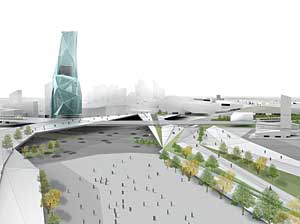For the large-scale redevelopment of Longgang Centre and Longcheng Square in Shenzhen, the United-Kingdom-based design collective Groundlab is turning the typical planning process upside-down.
Rather than adhere to the top-down approach taken by “big bureaucrats sitting at tables with big markers,” Groundlab is working from the bottom up, explains Eva Castro, a Groundlab partner and director of the Architectural Association’s Landscape Urbanism (AALU) masters program. “Instead of mapping [sites], which is a known hierarchical way of lifting up all the information contained within a territory,” says Castro, Groundlab chooses to “lift up systems” of particular interest. In their plan for Longgang, which they call “Deep Ground,” the designers identified the key system a network of “urban villages.”

Groundlab’s unorthodox methodology is what defines both its practice and its projects. Formed by a group of international designers and graduates of the AALU, it eschews tried-and-true methods in favor of “finding the limits of landscape urbanism as a concept,” by applying its theories on a large scale, says Castro. The Shenzhen project, which would raze 90 percent of the mostly industrial Longgang area to create a new commercial and cultural district, provides an ideal testing ground.
What attracted Groundlab to the urban villages of Longgang was the unusually intimate scale at which they operate. Castro likens them to favelas, “but without the social and economic implications of poverty.” Maintaining such places is particularly important in Chinese cities, since so much of “a human scale” has been lost there in recent years.
While the retention of urban villages is a key component of Groundlab’s design, its most innovative proposal is for a landscape intervention the designers call “thickened ground.” “We wanted to multiply a public level that would be accessible by everyone,” explains Castro. So using the methodology of cutting and folding, Groundlab created more streetscape while “avoiding sprawl,” and avoiding hierarchy. The multiple layers of a thickened ground increase the availability of commercial space, while providing for necessities like street-level parking.
Potential investors as well as local and regional municipalities have responded strongly to Deep Ground, allowing it to move ahead, Top priorities for the strategic design phase, says Castro, are to develop regions of thickened ground near elevated rail stations, and to create a main plaza that will “not only [be] the heart of the business district but also the core of the identity or the image” for a new Longgang.



Post a comment to this article
Report Abusive Comment